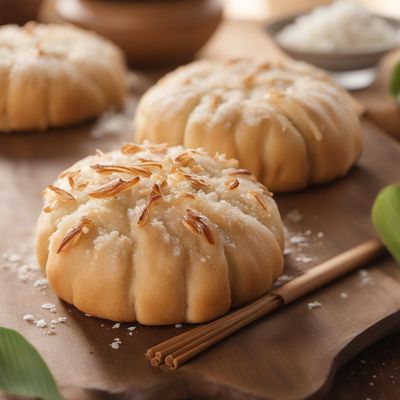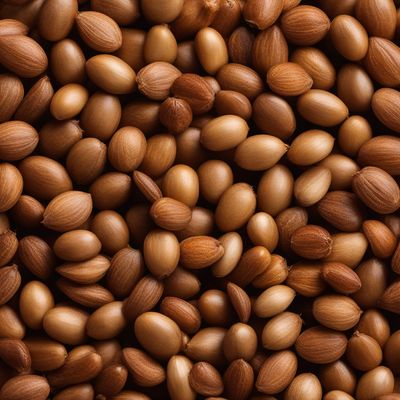
Ingredient
Bambara groundnut (fresh seeds)
The Nutty Gem: Fresh Bambara Groundnut Seeds
Fresh Bambara groundnut seeds are small, oval-shaped legumes with a thin brown skin and a creamy white interior. They have a distinct nutty flavor that is reminiscent of peanuts, with a slightly sweet undertone. When cooked, they become tender and creamy, making them perfect for stews, soups, or even roasted as a snack.
Origins and history
Bambara groundnuts have a long history in African cuisine, particularly in West and Central Africa. They are believed to have originated in the region and have been cultivated for thousands of years. These nutrient-dense legumes have played a crucial role in the diets of many African communities, providing a sustainable source of protein, fiber, and essential minerals.
Nutritional information
Fresh Bambara groundnut seeds are a nutritional powerhouse, packed with protein, dietary fiber, and essential minerals such as potassium, magnesium, and phosphorus. They are also a good source of B vitamins and antioxidants. Additionally, they are relatively low in fat and calories, making them a healthy addition to a balanced diet.
Allergens
There are no known allergens associated with fresh Bambara groundnut seeds.
How to select
When selecting fresh Bambara groundnut seeds, look for plump, unblemished seeds with a smooth and intact skin. Avoid seeds that are discolored, shriveled, or have a moldy appearance. If purchasing from a farmers market, choose seeds that are freshly harvested for optimal flavor and quality.
Storage recommendations
To maintain the freshness and quality of fresh Bambara groundnut seeds, store them in a cool, dry place in an airtight container. They can also be stored in the refrigerator to extend their shelf life. If the seeds are shelled, use them within a few weeks to prevent them from becoming rancid.
How to produce
Fresh Bambara groundnut seeds can be grown in warm climates with well-drained soil. They require full sun and regular watering. Plant the seeds directly in the ground or in large containers, ensuring they have enough space to grow. Harvest the pods when they turn yellow and dry them thoroughly before shelling the seeds.
Preparation tips
Fresh Bambara groundnut seeds can be boiled, roasted, or ground into flour for various culinary applications. They are commonly used in stews, soups, and sauces, adding a rich and nutty flavor. They can also be incorporated into salads, stir-fries, or used as a topping for baked goods. To enhance their flavor, lightly roast the seeds before using them in recipes.
Substitutions
Peanuts can be used as a substitute for fresh Bambara groundnut seeds, as they share a similar nutty flavor. However, the texture may differ slightly. Alternatively, chickpeas or other legumes can be used as a substitute in certain recipes.
Culinary uses
Fresh Bambara groundnut seeds are widely used in African cuisine, particularly in West and Central Africa. They are a common ingredient in dishes such as groundnut soup, maafe (peanut stew), and akara (fried bean cakes). They are also enjoyed as a snack, either roasted or boiled.
Availability
Fresh Bambara groundnut seeds are primarily cultivated and consumed in various countries across Africa, including Nigeria, Ghana, Mali, and Cameroon. They can also be found in specialty African grocery stores or online retailers that offer a wide range of African ingredients.
More ingredients from this category
Recipes using Bambara groundnut (fresh seeds) » Browse all

Jabukovača - Serbian Apple Pie
Heavenly Delight: Serbian Apple Pie - A Sweet Symphony of Flavors

Delicious Maple Pecan Bars
Maple Pecan Bliss Bars: A Sweet Canadian Delight

Authentic Argentinian Empanadas Tucumanas
Savory Delights: Traditional Argentinian Empanadas Tucumanas

Acehnese-style Stuffed Steamed Buns
Fluffy Delights from Aceh: Acehnese-style Stuffed Steamed Buns

Churer Meat Pie
Savory Swiss Delight: Churer Meat Pie

Cantonese-style Coconut Buns
Coconutty Delights: Cantonese-style Paifala

Floribbean Mummentaart
Tropical Delight: Floribbean Mummentaart

Homemade Butterscotch Pie
Velvety Butterscotch Bliss: A Decadent Delight

Vegetarian Karelian Pies
Savory Delights: Vegetarian Karelian Pies - A Finnish Culinary Gem

Russian Pirog with a Twist
Savory Delight: A Modern Twist on Traditional Russian Pirog

Ogbono Soup with a Twist
Savory Delight: A Modern Twist on Nigerian Ogbono Soup

Chinese Steamed Piggy Buns
Fluffy Pork-Filled Delights: Chinese Steamed Piggy Buns
